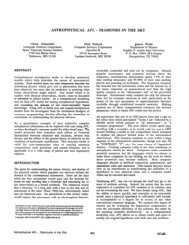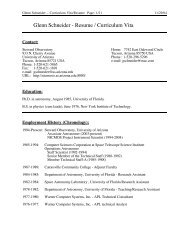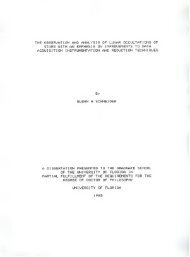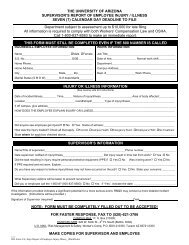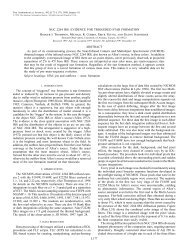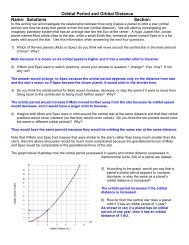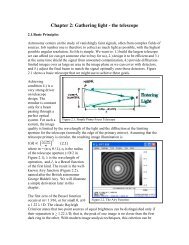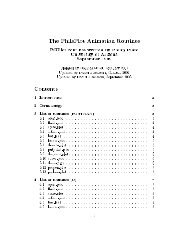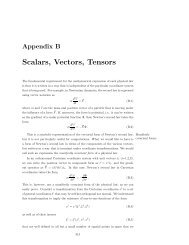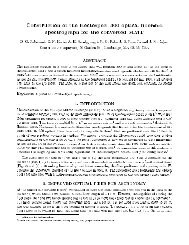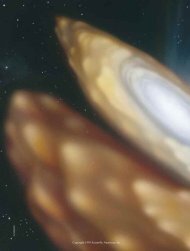The Cause of Moon Phases Name: SOLUTIONS Section:
The Cause of Moon Phases Name: SOLUTIONS Section:
The Cause of Moon Phases Name: SOLUTIONS Section:
Create successful ePaper yourself
Turn your PDF publications into a flip-book with our unique Google optimized e-Paper software.
<strong>The</strong> <strong>Cause</strong> <strong>of</strong> <strong>Moon</strong> <strong>Phases</strong><br />
<strong>Name</strong>: <strong>SOLUTIONS</strong> Correct responses shown in boldface. <strong>Section</strong>:<br />
Figure 1 shows Earth, the Sun, and five different possible positions for the <strong>Moon</strong> during one full orbit<br />
(dotted line). It is important to recall that one half <strong>of</strong> the <strong>Moon</strong>’s surface is illuminated by sunlight at all<br />
times. For each <strong>of</strong> the five positions <strong>of</strong> the <strong>Moon</strong> shown below, the <strong>Moon</strong> has been shaded on one side to<br />
darken the half <strong>of</strong> the <strong>Moon</strong>’s surface that is NOT being illuminated by sunlight. Note that this drawing is<br />
not to scale.<br />
1) Which <strong>Moon</strong> position (A-E) best corresponds with the moon phase shown in the upper right corner <strong>of</strong><br />
Figure 1? Make sure that the moon position you choose correctly predicts a moon phase in which only<br />
a small crescent <strong>of</strong> light on the left-hand side <strong>of</strong> the <strong>Moon</strong> is visible from Earth.<br />
Enter the letter <strong>of</strong> your choice:__D_______ It is a crescent so it must be D or E and D is correct<br />
because <strong>of</strong> the direction that the "horns" are facing -- away from the Sun so that the illuminated side <strong>of</strong> the<br />
is on the left.<br />
Orbit <strong>of</strong> the <strong>Moon</strong><br />
A<br />
B<br />
Earth<br />
E<br />
D<br />
moon phase<br />
Sun<br />
C<br />
Figure 1<br />
2) Shade in each <strong>of</strong> the four <strong>Moon</strong>s drawn in Figure 2 to darken the portion <strong>of</strong> the <strong>Moon</strong>’s surface that will<br />
NOT be illuminated by sunlight. Use Figure 2 to answer questions 3-5. <strong>The</strong> side <strong>of</strong> the <strong>Moon</strong> facing<br />
towards the Sun is always illuminated (except on the rare occasion <strong>of</strong> a lunar eclipse. Consequently the<br />
Orbit <strong>of</strong> the <strong>Moon</strong><br />
G<br />
moon phase<br />
H<br />
Earth<br />
F<br />
Sun<br />
I<br />
Figure 2
left hand half <strong>of</strong> all the <strong>Moon</strong>s should be shaded to indicate that those areas are not illuminated.<br />
3) Which <strong>Moon</strong> position (F-I) best corresponds with the moon phase shown in the upper right corner <strong>of</strong><br />
Figure 2?<br />
Enter the letter <strong>of</strong> your choice:__F___<br />
4) How much <strong>of</strong> the entire <strong>Moon</strong>’s surface is illuminated by the Sun during this phase?<br />
Circle one:<br />
• None <strong>of</strong> the surface is illuminated.<br />
• Less than half <strong>of</strong> the surface is illuminated.<br />
• Half <strong>of</strong> the surface is illuminated.<br />
• More than half <strong>of</strong> the surface is illuminated.<br />
• All <strong>of</strong> the surface is illuminated.<br />
5) How much <strong>of</strong> the <strong>Moon</strong>'s illuminated surface is visible from Earth for this phase <strong>of</strong> the <strong>Moon</strong>?<br />
Circle one:<br />
• None <strong>of</strong> the surface (visible from Earth) is illuminated.<br />
• Less than half <strong>of</strong> the surface (visible from Earth) is illuminated.<br />
• Half <strong>of</strong> the surface (visible from Earth) is illuminated.<br />
• More than half <strong>of</strong> the surface (visible from Earth) is illuminated.<br />
• All <strong>of</strong> the surface (visible from Earth) is illuminated.<br />
6) Consider the following debate between two students about the cause <strong>of</strong> the phases <strong>of</strong> the <strong>Moon</strong>.<br />
Student 1: <strong>The</strong> phase <strong>of</strong> the <strong>Moon</strong> depends on how the <strong>Moon</strong>, Sun and Earth are aligned with one<br />
another. During some alignments only a small portion <strong>of</strong> the <strong>Moon</strong>’s surface will receive<br />
light from the Sun, in which case we would see a crescent moon.<br />
Student 2: I disagree. <strong>The</strong> <strong>Moon</strong> would always get the same amount <strong>of</strong> sunlight; it’s just that in some<br />
alignments Earth casts a larger shadow on the <strong>Moon</strong>. That’s why the <strong>Moon</strong> isn’t always a<br />
full moon.<br />
Do you agree or disagree with either or both <strong>of</strong> the students?<br />
A: Agree with Student 1 but not Student 2<br />
B: Agree with Student 2 but not Student 1<br />
C: Agree with neither <strong>of</strong> them<br />
D: Agree with both <strong>of</strong> them<br />
Why?<br />
You should disagree with both students -- look at Figure 2 to see that half <strong>of</strong> the <strong>Moon</strong>'s surface<br />
is always illuminated thus disproving Student 1's argument.<br />
Student 2 is wrong because the Earth's shadow always point away from the Sun and wouldn't<br />
hit the <strong>Moon</strong> at all unless the <strong>Moon</strong> were full and the orbits line up. <strong>The</strong> Earth's shadow is no<br />
where near the <strong>Moon</strong> at quarter moon or at new moon, for example.




